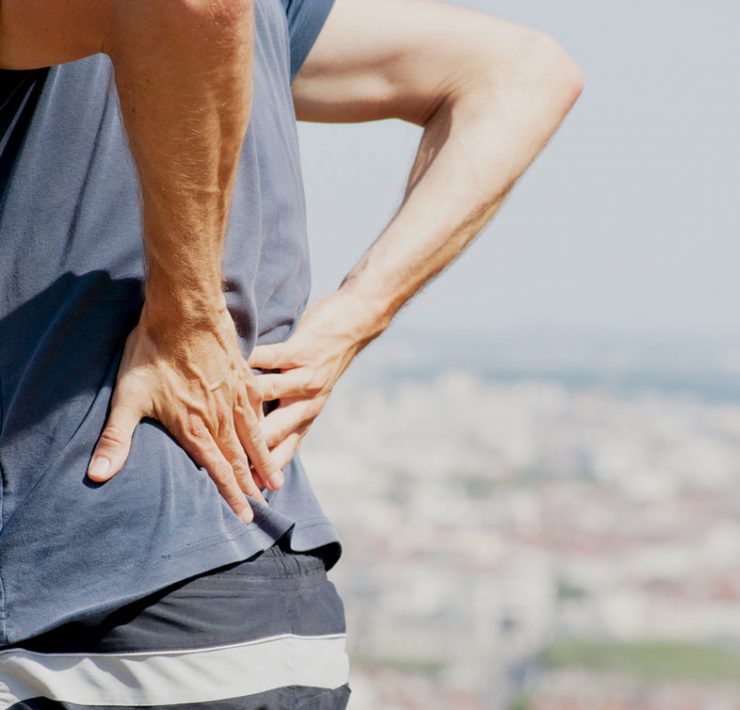Riddle me this: what’s five times as strong as steel (pound for pound), joined to a strand of 30 identical counterparts, and can fit in the palm of your hand?
Any guesses?
Alright, I’ll just tell you… it’s your vertebrae.
That’s right, the 30 or so small bones that make up your spine are both very lightweight and incredibly strong.
But when this delicate strand of powerful bones shifts out of place or experiences unnecessary strain, it can be seriously painful.
Your low back houses the lumbar portion of your spine and carries the weight of your torso while flexing to accommodate everything you do throughout your day.
low back pain is actually the top reason for work-related disability worldwide
This leaves your low back vulnerable to degeneration or injury, which can lead to pain that ranges from frustrating to excruciating.
Many people don’t realize just how common lower back pain is. Low back pain is actually the top reason for work-related disability worldwide, according to one study, and most people experience low back pain at some point in their life.
But how do you tell whether your lower back pain is a temporary annoyance or something more serious?
And what are the best natural treatments to relieve your pain?
We’ll cover all that and more today.
Top causes of lower back pain
Your low back serves the important – and often overlooked – job of supporting your entire torso. Swiveling around and moving side to side all day long under the weight of your upper body is hard work, and eventually, it can take a toll on the structures of your low back.
Let’s begin with the good news first: the majority of back pain will resolve on its own within a few weeks.
But if your back pain lasts for three months or more, you have what’s considered chronic back pain.
When back pain persists, it’s important to pay attention to all of the symptoms that go with it, including any numbness or tingling. The quality of the pain – sharp or dull – is also important, as well as the frequency.
Once you’re paying closer attention to the sensations in your low back, it’s time to discuss possible causes.
While the pain you experience could stem from your muscles, nerves, or abdominal organs, the top source for most low back pain is the spine itself. In this article, we’ll focus on the potential causes of pain that originate in the spine.
Sprain or strain
You snap around quickly to greet your friend who just called your name from down the block. Or, you whip your torso forward to create the force behind a game-winning tennis serve. All of a sudden, a burning sensation runs down your spine.
And just like that, you’ve strained or sprained your low back.
The majority of acute low back pain is caused by a sprain or strain of the structures in the spine. Strains are an injury to the muscle or tendon, which connects muscle to bone. Sprains happen in the joints and are injuries to the ligaments, which connect your bones to other bones.
Spondylolisthesis
This extra-long word describes a condition in which your lower spinal vertebrae shift and press against the spinal nerves.
While some people inherit genes that leave them susceptible to this disease, some athletes get it because of chronic overuse of certain movements in their sport of choice. Football, track, weightlifting, and gymnastics are common culprits.
Sciatica
Sciatica is caused by compression of the sciatic nerve, which runs from the lumbar spine down into the leg, and can lead to pain, numbness, tingling, and other symptoms from the low back to the buttocks and down to the outer calf.
The best treatments for lower back pain
Movement and exercise
It might sound counterintuitive when you’re in the thick of acute back pain, but the new science of back pain supports non-drug therapies including movement and exercise as some of the best options for acute low back pain.
Bar none, the best treatment for acute low back pain is to get back to your normal level of movement as soon as possible. This can be via brisk walking and light stretching or jogging. The research shows that whether you do back-specific exercises or general conditioning, all moderate exercise is effective for treating both acute and chronic back pain.
Pharmaceutical options
If pharmacological treatments are being used, NSAIDs such as ibuprofen may be a valid treatment for reducing pain and inflammation in the low back. You should always consult with your healthcare provider on the proper dose and course of treatment for any medication.
Professional therapeutic massage
The science supports massage as a natural treatment for acute low back pain. Even if you’ve never considered massage as an option for treating your back pain before, it’s never too late to give your first professional massage a try. Remember that the spine is one long interconnected network of joints, so taking good care of your neck can affect the health of your low back as well. No matter which massage therapist you choose, be sure you give them a full explanation of your medical history, including any treatments you’ve already tried for your back pain and any back procedures you’ve had in the past.
Finding relief for lower back pain
Remember, you are your own health advocate and you deserve to find the best solutions for your own body. This should go without saying, but no article on the internet can substitute for the skilled advice of your trained medical provider.
If you are experiencing fever, recently unexpected weight loss, incontinence or difficulty urinating, progressive numbness or tingling in conjunction with your acute low back pain, consult your medical provider as soon as possible.
Margo Carroll is a marketing strategist and email funnel copywriter for online business owners. She has worked with many massage therapists and has been featured in Massage magazine, the Massage Business Blueprint and MindBodyGreen. Learn more about Margo at margocaroll.com and on LinkedIn.








